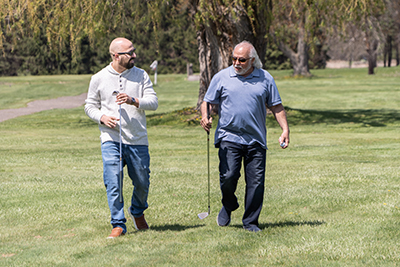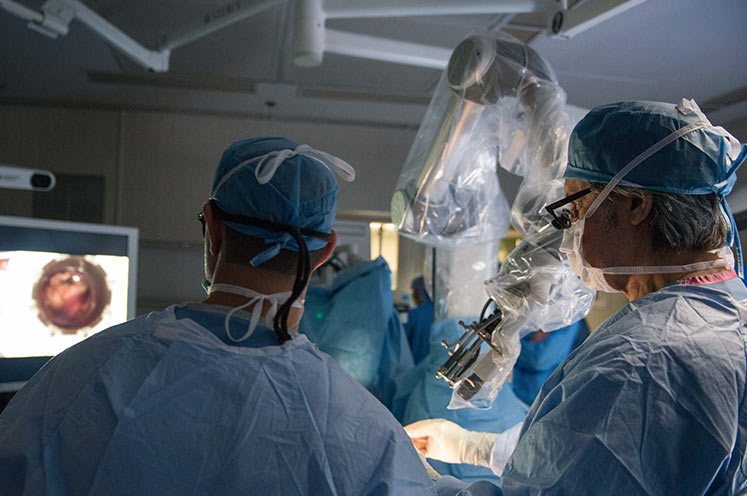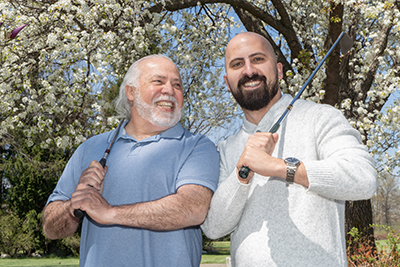Meet the Team
Renowned experts that specialize in treating and removing brain tumors.
 At age 25, Hassan Elsayed had average interests – building, boating, golf, and music. But he didn’t know he was going to do something very un-average – he would be awake while brain surgery was performed. Not once. But twice within two years. Adam Robin, M.D. surgical director of Henry Ford’s Brain Metastases Program would be the expert who pinpointed the exact areas where a glioma had entangled itself deep into Hassan’s brain.
At age 25, Hassan Elsayed had average interests – building, boating, golf, and music. But he didn’t know he was going to do something very un-average – he would be awake while brain surgery was performed. Not once. But twice within two years. Adam Robin, M.D. surgical director of Henry Ford’s Brain Metastases Program would be the expert who pinpointed the exact areas where a glioma had entangled itself deep into Hassan’s brain.
Following up on a childhood issue with his pituitary gland, Hassan visited his endocrinologist, and an MRI showed a tiny area of damaged brain tissue – cause unknown.
“The doctor told me, not to worry and come back in one year,” recalls Hassan. “I forgot about it, and five years later, I was having chronic, dull headaches. My mind would go blank, and I’d space out for a few seconds or a minute.”
Physicians in Garden City referred him to Henry Ford in downtown Detroit, where another MRI led to his diagnosis: oligodendroglioma, an infiltrating brain tumor that could be pre-malignant.
In December of 2020, Dr. Robin would perform Hassan’s first awake craniotomy. Hassan was sedated, and Dr. Robin used medication to numb the scalp and skull. Then he performed surgery to expose part of the brain. Next, a reassuring neuro-anesthesiologist, Ravnita Sharma-Roberts, M.D., brought Hassan out of sedation to full consciousness. Hassan felt minimal, if any, pain. “There are no nerve endings or pain fibers within the brain,” says Dr. Robin.
“While the patient is awake, brain mapping is done to identify and protect areas critical for brain function,” says Dr. Robin. First, the motor and sensory areas were identified. Then, the speech and language areas were located as Dr. Robin asked Hassan to count to 10 and do a bicep curl.

Next, a stimulus temporarily stopped Hassan’s speech, and this helped to determine the amount of electrical stimulation required for the next part of surgery. After that, Anne Merhar a speech-language pathologist asked Hassan to identify numerous images to help Dr. Robin distinguish between the various aspects of speech and language function areas near the tumor.
After mapping, tumor removal began. Dr. Robin continued talking with Hassan about a variety of topics – TV shows, friends, family, work and childhood memories. “It’s important to hear patients so we can preserve functions as we remove the infiltrating tumor,” says Dr. Robin.
“Talking to patients for an hour or two during surgery, we get to know them on a whole new level, and we have respect and admiration for them. They contribute to getting the tumor out. It’s a team effort,” says Dr. Robin.
 After reviewing the case, the tumor board believed the surgery would have a lasting result. But months later, another MRI showed something unusual near the speech and motor areas. Scar tissue or pre-malignant tumor cells? Only a second surgery could make the determination.
After reviewing the case, the tumor board believed the surgery would have a lasting result. But months later, another MRI showed something unusual near the speech and motor areas. Scar tissue or pre-malignant tumor cells? Only a second surgery could make the determination.
A courageous Hassan consented.
“During the surgery, I remember the doctor was pointing to pictures and saying, ‘What is this, what is that’. I woke up and didn’t know why I was in the hospital. I couldn’t put words into the air for three or four days. I couldn’t talk,” says Hassan. “I was uncomfortable, but the staff was amazing. They were kind and compassionate to me and everyone.”
Fortunately, only scar tissue and a few rare tumor cells were found – nothing malignant, says Dr. Robin.
After recovering at home for a couple weeks, the headaches and “suture feelings” went away, but Hassan was left with a scar from the top of his head to his ear. Because his hair has not regrown completely, Hassan keeps his head shaved.
Within five weeks, Hassan would be building cabinets and remodeling homes again with his dad. Using Kepra, an anti-seizure medication, Hassan has confidence in his ability to function normally. “At work, when something’s done and it’s done right, I think – hey, I did that,” smiles Hassan, sitting in the home he shares with his mom and sister in Dearborn.
“When Hassan found out about this tumor, he initially had a very normal reaction, and he did not want to address it with surgery. But Hassan is unique because he learned more about it. He continued to get the follow-up scans and eventually he wanted to meet the problem head-on. He addressed it despite his initial trepidation. That’s a really cool thing – sometimes a hard thing for people to do,” says Dr. Robin.
“My parents, two brothers and two sisters were there for me through thick and thin,” says Hassan. “My dad especially was strong and comforting. I look forward to golfing with him this summer.”
Hassan says his faith also helped. “I go to the mosque every few months, and I thought God was giving me a test. But I also believed he would pull me through.”
“Throughout my life I’ve had to deal with a lot of BS. That made me stronger. It brought me closer to God,” says Hassan. “Now, I have an accepting attitude that developed after disappointments and heartbreak.”
Hassan’s advice? See your doctor when you have any unusual symptoms. Follow your doctor’s instructions and believe in God.
His future? Do something average – like buy a house or study law enforcement.
We use cookies to improve your website experience. By using this site, you agree to our Terms of Use. Read our Internet Privacy Statement to learn what information we collect and how we use it.